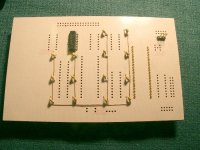RickNel
Veteran Member
Any suggestions on a good source for wire-wrap IC sockets, loose pins and wire?
The online sources I have located so far either will not ship outside US/Canada, or they demand huge minimum order sizes, or they charge 200% premium prices, or they stock a very limited range, or all of the above.
Also, has anyone come across 40-50 pin IDC headers with wire-wrap extended pins? Haven't found them in any catalogs so far.
Maybe there's a brilliant little stockist somewhere who would like one more customer?
Thanks for any ideas...
Rick
The online sources I have located so far either will not ship outside US/Canada, or they demand huge minimum order sizes, or they charge 200% premium prices, or they stock a very limited range, or all of the above.
Also, has anyone come across 40-50 pin IDC headers with wire-wrap extended pins? Haven't found them in any catalogs so far.
Maybe there's a brilliant little stockist somewhere who would like one more customer?
Thanks for any ideas...
Rick

